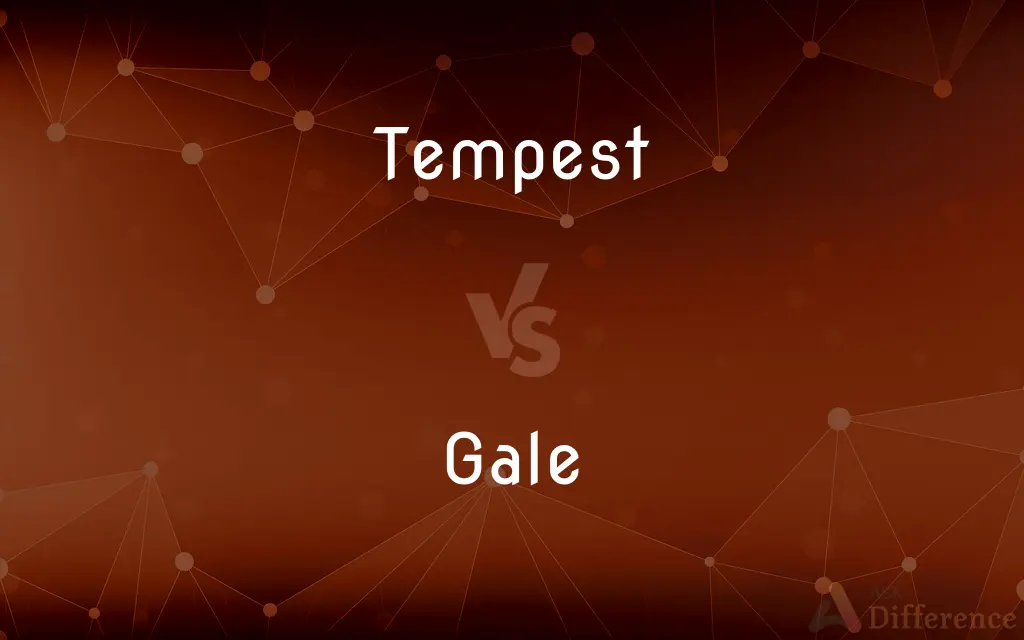Tempest vs. Gale — What's the Difference?
Edited by Tayyaba Rehman — By Fiza Rafique — Updated on April 24, 2024
A tempest is a violent storm with wind, rain, or snow, often metaphorical for turmoil, while a gale is a strong wind, often part of storm systems, categorized on the Beaufort scale.

Difference Between Tempest and Gale
Table of Contents
ADVERTISEMENT
Key Differences
A tempest is a broad term for a violent storm, which may include thunder, lightning, heavy rain, or snow, illustrating nature's ferocity. In contrast, a gale specifically refers to a very strong wind, typically within a storm, measured for its intensity on the Beaufort scale.
While a tempest can encompass a variety of weather elements and is often used in literature to symbolize chaos or emotional turmoil, a gale is more specifically defined and usually pertains only to the wind aspect of stormy weather.
Tempests are commonly featured in narratives and expressions to denote severe disturbances or upheavals, both meteorological and metaphorical. On the other hand, gales are frequently mentioned in weather forecasts and maritime contexts, focusing on their impact on navigation and sea conditions.
The term "tempest" tends to evoke a sense of drama and all-encompassing disorder, suitable for describing both literal and figurative storms. Conversely, "gale" is often used in a more technical sense, indicating strong wind speeds that are significant but not necessarily part of a larger storm system.
Despite both terms describing aspects of stormy weather, a tempest usually implies a situation of greater magnitude and intensity, while a gale, though powerful, is more narrowly defined and less chaotic in scope.
ADVERTISEMENT
Comparison Chart
Definition
A violent storm with varied elements
A strong wind, often during storms
Usage
Broader, both literal and metaphorical
Primarily literal, technical
Symbolism
Chaos, upheaval
Strong but manageable challenges
Beaufort Scale
Not specific to scale
Specific category (8-9)
Common Contexts
Literary, general descriptions
Weather forecasts, maritime settings
Compare with Definitions
Tempest
A violent storm with wind, rain, thunder, or snow.
The ship battled through the tempest.
Gale
Defined on the Beaufort scale as wind speeds of 34 to 40 knots.
The weather service issued a gale warning for the coast.
Tempest
A term often used in literature to describe severe storms or conflicts.
Shakespeare's play The Tempest explores themes of magic and betrayal.
Gale
Can be part of a larger storm system but specifically refers to wind.
The storm brought rain and gales to the area.
Tempest
Metaphorically, a violent or tumultuous situation.
His resignation caused a tempest in the organization.
Gale
Often impacts sea conditions, making navigation hazardous.
Fishermen avoid the sea during a gale.
Tempest
Any situation resembling a violent storm.
The crowd erupted into a tempest of protest.
Gale
A very strong wind, typically used in meteorological contexts.
The gale forced them to secure all loose objects.
Tempest
Dramatically turbulent or chaotic.
The tempest of emotions overwhelmed her.
Gale
Used to describe strong but not storm-level winds.
A gale blew through the valley, stripping leaves from the trees.
Tempest
A violent windstorm, frequently accompanied by rain, snow, or hail.
Gale
A gale is a strong wind, typically used as a descriptor in nautical contexts. The U.S. National Weather Service defines a gale as 34–47 knots (63–87 km/h, 17.5–24.2 m/s or 39–54 miles/hour) of sustained surface winds.
Tempest
Furious agitation, commotion, or tumult; an uproar
"The tempest in my mind / Doth from my senses take all feeling" (Shakespeare).
Gale
A wind with a speed of from 34 to 40 knots (39 to 46 miles per hour; 63 to 74 kilometers per hour), according to the Beaufort scale. Also called fresh gale.
Tempest
To cause a tempest around or in.
Gale
A storm at sea.
Tempest
A storm, especially one with severe winds.
Gale
Often gales A forceful outburst
Gales of laughter.
Tempest
Any violent tumult or commotion.
Gale
The sweet gale.
Tempest
(obsolete) A fashionable social gathering; a drum.
Gale
To sing; charm; enchant.
Tempest
To storm.
Gale
To cry; groan; croak.
Tempest
To disturb, as by a tempest.
Gale
To talk.
Tempest
An extensive current of wind, rushing with great velocity and violence, and commonly attended with rain, hail, or snow; a furious storm.
[We] caught in a fiery tempest, shall be hurled,Each on his rock transfixed.
Gale
To call.
Tempest
Fig.: Any violent tumult or commotion; as, a political tempest; a tempest of war, or of the passions.
Gale
To sing; utter with musical modulations.
Tempest
To disturb as by a tempest.
Part huge of bulkWallowing unwieldy, enormous in their gait,Tempest the ocean.
Gale
(nautical) To sail, or sail fast.
Tempest
To storm.
Gale
(meteorology) A very strong wind, more than a breeze, less than a storm; number 7 through to 9 winds on the 12-step Beaufort scale.
It's blowing a gale outside.
Many parts of the boat were damaged in the gale.
Tempest
A violent commotion or disturbance;
The storms that had characterized their relationship had died away
It was only a tempest in a teapot
Gale
An outburst, especially of laughter.
A gale of laughter
Tempest
(literary) a violent wind;
A tempest swept over the island
Gale
A light breeze.
Gale
A shrub, also called sweet gale or bog myrtle (Myrica gale), that grows on moors and fens.
Gale
(archaic) A periodic payment, such as is made of a rent or annuity.
Gale day - the day on which rent or interest is due.
Gale
A strong current of air; a wind between a stiff breeze and a hurricane. The most violent gales are called tempests.
Gale
A moderate current of air; a breeze.
A little gale will soon disperse that cloud.
And winds of gentlest gale Arabian odors fannedFrom their soft wings.
Gale
A state of excitement, passion, or hilarity.
The ladies, laughing heartily, were fast getting into what, in New England, is sometimes called a gale.
Gale
A song or story.
Gale
A plant of the genus Myrica, growing in wet places, and strongly resembling the bayberry. The sweet gale (Myrica Gale) is found both in Europe and in America.
Gale
The payment of a rent or annuity.
Gale
To sale, or sail fast.
Gale
To sing.
Gale
A strong wind moving 45-90 knots; force 7 to 10 on Beaufort scale
Common Curiosities
Can a gale occur without a tempest?
Yes, gales can occur as strong winds independent of a full storm system.
What is the main difference between a tempest and a gale?
A tempest refers to a violent storm possibly involving various elements, while a gale specifically denotes strong wind.
How are tempests usually depicted in literature?
Tempests in literature often symbolize great turmoil or conflict.
What types of weather can a tempest include?
A tempest can include thunder, lightning, strong winds, heavy rain, or snow.
Is a gale dangerous?
Gales can be dangerous, especially in maritime contexts due to their strong winds.
Can the term "tempest" be used metaphorically?
Yes, "tempest" is often used metaphorically to describe tumultuous situations.
What is the Beaufort scale range for a gale?
On the Beaufort scale, a gale ranges from 34 to 40 knots.
How do sailors prepare for a gale?
Sailors secure their vessels and reduce sail area to safely navigate through gales.
Why is the term "tempest" evocative in describing storms?
"Tempest" conveys a sense of overwhelming and dramatic natural forces.
How do tempests and gales differ in their impact?
Tempests can have a wide-ranging impact including multiple weather elements, while gales primarily impact through wind.
Share Your Discovery

Previous Comparison
Dungarees vs. Overalls
Next Comparison
Fashionable vs. StylishAuthor Spotlight
Written by
Fiza RafiqueFiza Rafique is a skilled content writer at AskDifference.com, where she meticulously refines and enhances written pieces. Drawing from her vast editorial expertise, Fiza ensures clarity, accuracy, and precision in every article. Passionate about language, she continually seeks to elevate the quality of content for readers worldwide.
Edited by
Tayyaba RehmanTayyaba Rehman is a distinguished writer, currently serving as a primary contributor to askdifference.com. As a researcher in semantics and etymology, Tayyaba's passion for the complexity of languages and their distinctions has found a perfect home on the platform. Tayyaba delves into the intricacies of language, distinguishing between commonly confused words and phrases, thereby providing clarity for readers worldwide.













































